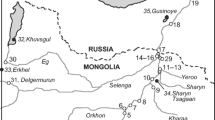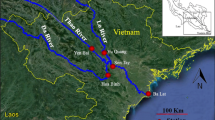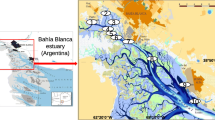Abstract
Metals undergo various processes transforming from one phase to another during transportation from head streams to oceans. The major chemical processes in the streams and rivers appear to be strongly dependent on dissolved organic matter (DOM). The mutualistic interactions between DOM and metals are important in determining the fate of many elements. We collected surface water samples from four stations along two mountainous streams in 2015 and analysed DOM quality and quantity and metal concentrations with the aim of understanding how changes in DOM characteristics are associated with dissolved metals along the stream with sabo dams. Both DOM and metal concentration were very low at the upstream site and did not show any significant correlation. However, sites within the dam vicinity (St.2 and St.3) had significantly high concentrations of manganese (Mn) and iron (Fe) which strongly correlated with molecular weight and aromaticity (> 0.6, p ≤ 0.01). Fe, Mn, copper (Cu) and aluminium (Al) significantly varied (p ≤ 0.05) downstream with highest average concentration for Al (17.7 ± 6.0 μg/L) and Cu (0.63 ± 0.3 μg/L). Cu had significant correlation with fluorescence components (fulvic-like, humic-like and protein like) and fluorescence index, while Fe significantly correlated to coloured DOM properties for all the sites. In the midstream section, strong correlations were exhibited by Fe, Cu, Zn and Mn whereas all metals did not show any significant correlation in the upstream site. Additionally, Cu, Mn and lead (Pb) showed strong correlation to DOM properties at the downstream site. The Fe to DOC and Mn to DOC ratios gave significant correlations with aromaticity, molecular weight and fulvic-like component at the midstream sections whereas Cu to DOC ratio lacked significant correlations to DOM at all the stations. Sabo dams enhanced Fe and Mn dissolution, while human activities in the downstream impacted Cu, Al, DOC, Mn and Fe stream concentrations. On the other hand, Fe and Mn were closely associated to DOM properties in regions of changing decreasing redox potential. The significant correlations presented by Mn, Fe and Cu with fluorescence index stresses the role of DOM heterogeneity in natural environments



Similar content being viewed by others
References
Åström M, Corin N (2000) Abundance, sources and speciation of trace elements in humus-rich streams affected by acid sulphate soils. Aquat Geochem 6(3):367–383. https://doi.org/10.1023/A:1009658231768
Aucour AM, Tao FX, Moreira-Turcq P, Seyler P, Sheppard S, Benedetti MF (2003) The Amazon River: Behaviour of metals (Fe, Al, Mn) and dissolved organic matter in the initial mixing at the Rio Negro/Solimões confluence. Chem Geol 197(1–4):271–285. https://doi.org/10.1016/S0009-2541(02)00398-4
Baken S, Degryse F, Verheyen L, Merckx R, Smolders E (2011) Metal complexation properties of freshwater dissolved organic matter are explained by its aromaticity and by anthropogenic ligands. Environ Sci Technol 45(7):2584–2590
Baken S, Salaets P, Desmet N, Seuntjens P, Vanlierde E, Smolders E (2015) Oxidation of iron causes removal of phosphorus and arsenic from streamwater in groundwater-fed lowland catchments. Environ Sci Technol 49(5):2886–2894. https://doi.org/10.1021/es505834y
Bauer M, Blodau C (2006) Mobilization of arsenic by dissolved organic matter from iron oxides, soils and sediments. Sci Total Environ 354(2–3):179–190. https://doi.org/10.1016/j.scitotenv.2005.01.027
Canfield DE, Thandrup B, Hansen JW (1993) The anaerobic degradation of organic matter in Danish coastal sediments: iron reduction, manganese reduction and sulphate reduction. Geochem Cosmochem Acta 57:3867–3883
ElBishlawi H, Jaffe PR (2015) Characterization of dissolved organic matter from a restored urban marsh and its role in the mobilization of trace metals. Chemosphere 127:144–151. https://doi.org/10.1016/j.chemosphere.2014.12.080
Frémion F, Bordas F, Mourier B, Lenain J-F, Kestens T, Courtin-Nomade A (2016) Influence of dams on sediment continuity: a study case of a natural metallic contamination. Sci Total Environ 547:282–294. https://doi.org/10.1016/j.scitotenv.2016.01.023
Gu Y, Lensu A, Perämäki S, Ojala A, Vähätalo AV (2017) Iron and pH regulating the photochemical mineralization of dissolved organic carbon. ACS Omega 2(5):1905–1914. https://doi.org/10.1021/acsomega.7b00453
Guo XJ, Zhu NM, Chen L, Yuan DH, He LS (2015) Characterizing the fluorescent properties and copper complexation of dissolved organic matter in saline-alkali soils using fluorescence excitation-emission matrix and parallel factor analysis. J Soils Sediments 15(7):1473–1482. https://doi.org/10.1007/s11368-015-1113-7
Harvey JW, Fuller CC (1998) Effect of enhanced manganese oxidation in the hyporheic zone on basin scale geochemical balance. Water Resour Res 34(4):623–636
Harvey CF, Swartz CH (2002) Arsenic mobility and groundwater extraction in Bangladesh. Science 298:1602–1606
Helms JR, Stubbins A, Ritchie JD, Minor EC, Kieber DJ, Mopper K (2008) Absorption spectral slopes and slope ratios as indicators of molecular weight, source, and photobleaching of chromophoric dissolved organic matter. Limnol Oceanogr 53:955–969. https://doi.org/10.4319/lo.2008.53.3.0955
Hood E, Gooseff MN, Johnson SL (2006) Changes in the character of stream water dissolved organic carbon during flushing in three small watersheds, Oregon. J Geophys Res Biogeosci 111(1):1–8. https://doi.org/10.1029/2005JG000082
Ingri J, Pekka L, Dauvalter V, Rodushkin I, Peinerud E (2011) Manganese redox cycling in Lake Imandra: impact on nitrogen and the trace metal sediment record. Biogeosci Discuss 8(1):273–321
Jansen B, Nierop KGJ, Verstraten JM (2003) Mobility of Fe(II), Fe(III) and Al in acidic forest soils mediated by dissolved organic matter: influence of solution pH and metal/organic carbon ratios. Geoderma 113(3–4):323–340. https://doi.org/10.1016/S0016-7061(02)00368-3
Jansen B, Nierop KGJ, Verstraten JM (2002) Influence of pH and metal/carbon ratios on soluble organic complexation of Fe(II), Fe(III) and Al(III) in soil solutions determined by diffusive gradients in thin films. Anal Chim Acta 454:259–270. https://doi.org/10.1016/S0003-2670(01)01551-3
Jaffe R, McKnight D, Maie N, Cory R, McDowell WH, Campbell JL (2008) Spatial and temporal variations in DOM composition in ecosystems: the importance of long-term monitoring of optical properties. J Geophys Res Biogeosci 113:1–15. https://doi.org/10.1029/2008JG000683
Kaiser K, Guggenberger G (2000) The role of DOM sorption to mineral surfaces in the preservation of organic matter in soils. Org Geochem 31(7–8):711–725. https://doi.org/10.1016/S0146-6380(00)00046-2
Kaiser E, Sulzberger B (2004) Phototransformation of riverine dissolved organic matter (DOM) in the presence of abundant iron: effect on DOM bioavailability. Limnol Oceanogr 49:540–554
Kikuchi T, Fujii M, Terao K, Jiwei R, Lee YP, Yoshimura C (2017) Correlations between aromaticity of dissolved organic matter and trace metal concentrations in natural and effluent waters: a case study in the Sagami River Basin, Japan. Sci Total Environ 576:36–45
Kostka JE, Luther GW III, Nealson KH (1995) Chemical and biological reduction of Mn (III) -pyrophosphate complexes: potential importance of dissolved Mn (III) as an environmental oxidant. Geochim Cosmochim Acta S9:5
Kuhn MK, Neubauer E, Hofmann T, Von Der Kammer F, Aiken GR, Maurice PA (2014) Concentrations and distributions of metals associated with dissolved organic matter from the Suwannee River (GA, USA). Environ Eng Sci 32(1):1–12. https://doi.org/10.1089/ees.2014.0298
Leenheer JJA, Croué JJ-P (2003) Characterizing aquatic dissolved organic matter. Environ Sci Technol 37(1):18A–26A. https://doi.org/10.1021/es032333c
Luan H, Vadas TM (2015) Size characterization of dissolved metals and organic matter in source waters to streams in developed landscapes. Environ Pollut 197:76–83. https://doi.org/10.1016/j.envpol.2014.12.004
Mantoura RFC, Dickson A, Riley JP (1978) The complexation of metals with humic materials in natural waters. Estuar Coast Mar Sci 6(4):387–408
McKnight DM, Boyer EW, Westerhoff PK, Doran PT, Kulbe T, Andersen DT (2001) Spectrofluorometric characterization of dissolved organic matter for indication of precursor organic material and aromaticity. Limnol Oceanogr 46:38–48
Miller MP, McKnight DM, Cory RM, Williams MW, Runkel RL (2006) Hyporheic exchange and fulvic acid redox reactions in an alpine stream/wetland ecosystem, Colorado front range. Environ Sci Technol 40(19):5943–5949. https://doi.org/10.1021/es060635j
Mostofa KMG, Liu C, Feng X, Yoshioka T (2013) Complexation of dissolved organic matter with trace metal ions in natural complexation of dissolved organic matter with trace metal ions in natural waters. https://doi.org/10.1007/978-3-642-32223-5
Murphy KR, Stedmon CA, Graeber D, Bro R (2013) Fluorescence spectroscopy and multi-way techniques. PARAFAC. Anal Methods 5(23):6557. https://doi.org/10.1039/c3ay41160e
Neff KJ, Schwartz JS, Moore SE, Kulp MA (2013) Influence of basin characteristics on baseflow and stormflow chemistry in the Great Smoky Mountains National Park, USA. Hydrol Process 27(14):2061–2074. https://doi.org/10.1002/hyp.9366
Nierop KGJ, Jansen B, Verstraten JM (2002) Dissolved organic matter, aluminium and iron interactions: Precipitation induced by metal/carbon ratio, pH and competition. Sci Total Environ 300(1–3):201–211. https://doi.org/10.1016/S0048-9697(02)00254-1
Nobuyuki T, Atsushi O, Yutaka I (1980-1981) Geological survey
Park J-H, Lee J-H, Kang S-Y, Kim S-Y (2007) Hydroclimatic controls on dissolved organic matter (DOM) characteristics and implications for trace metal transport in Hwangryong River Watershed, Korea, during a summer monsoon period. Hydrol Process 21:3025–3034. https://doi.org/10.1002/hyp.6511
Poulin BA, Ryan JN, Aiken GR (2014) Effects of iron on optical properties of dissolved organic matter. Environ Sci Technol 48(17):10098–10106. https://doi.org/10.1021/es502670r
Praise S, Ito H, An Y, Watanabe K, Watanabe T (2018) Dissolved organic matter characteristics along sabo dammed streams based on ultraviolet visible and fluorescence spectral properties. Environ Monit Assess 190(3):146. https://doi.org/10.1007/s10661-018-6518-5
Praise S, Watanabe T, Watanabe K, Ito H, Okubo H (2017) Impact of closed sabo dams on manganese concentration change in mountainous streams. Int J River Basin Manag 15(1). https://doi.org/10.1080/15715124.2016.1209510
Ren ZL, Tella M, Bravin MN, Comans RN, Dai J, Garnier JM et al (2015) Effect of dissolved organic matter composition on metal speciation in soil solutions. Chem Geol 398:61–69
Riedel T, Zak D, Biester H, Dittmar T (2013) Iron traps terrestrially derived dissolved organic matter at redox interfaces. Proc Natl Acad Sci U S A 110(25):10101–10105. https://doi.org/10.1073/pnas.1221487110
Shikazono N, Tatewaki K, Mohiuddin KM, Nakano T, Zakir HM (2012) Sources, spatial variation, and speciation of heavy metals in sediments of the Tamagawa River in Central Japan. Environ Geochem Health 34(SUPPL. 1):13–26. https://doi.org/10.1007/s10653-011-9409-z
Slaveykova VI, Wilkinson KJ (2005) Predicting the bioavailability of metals and metal complexes: critical review of the biotic ligand model. Environ Chem 2:9–24
Uyguner CS, Bekbolet M (2005) Implementation of spectroscopic parameters for practical monitoring of natural organic matter. Desalination 176(1–3 SPEC. ISS):47–55. https://doi.org/10.1016/j.desal.2004.10.027
Warren L a, Haack E a (2001) Biogeochemical controls on metal behaviour in freshwater environments. Earth Sci Rev 54(4):261–320. https://doi.org/10.1016/S0012-8252(01)00032-0
Weishaar JL, Aiken GR, Bergamaschi B a, Fram MS, Fujii R, Mopper K (2003) Evaluation of specific ultraviolet absorbance as an indicator of the chemical composition and reactivity of dissolved organic carbon. Environ Sci Technol 37(20):4702–4708. https://doi.org/10.1021/es030360x
Worms I, Simon DF, Hassler CS, Wilkinson KJ (2006) Bioavailability of trace metals to aquatic microorganisms: importance of chemical, biological and physical process on biouptake. Biochimie 88:1721–1731. https://doi.org/10.1016/j.biochi.2006.09.008
Xiao YH, Räike A, Hartikainen H, Vähätalo AV (2015) Iron as a source of color in river waters. Sci Total Environ 536:914–923. https://doi.org/10.1016/j.scitotenv.2015.06.092
Yan M, Ma J, Ji G (2016) Examination of effects of Cu(II) and Cr(III) on Al(III) binding by dissolved organic matter using absorbance spectroscopy. Water Res 93:84–90
Author information
Authors and Affiliations
Corresponding author
Additional information
Responsible editor: Céline Guéguen
Publisher’s note
Springer Nature remains neutral with regard to jurisdictional claims in published maps and institutional affiliations.
Electronic supplementary material
ESM 1
(DOCX 1056 kb)
Rights and permissions
About this article
Cite this article
Praise, S., Ito, H., Watanabe, K. et al. Association of dissolved organic matter characteristics and trace metals in mountainous streams with sabo dams. Environ Sci Pollut Res 27, 456–468 (2020). https://doi.org/10.1007/s11356-019-06911-3
Received:
Accepted:
Published:
Issue Date:
DOI: https://doi.org/10.1007/s11356-019-06911-3




